Are you curious about the night birds in Florida? These are some of the most amazing and diverse creatures in the state. In this guide, you will learn about 13 kinds of night birds, from their appearance and sounds to their habits and diet. Whether you are a birdwatcher or just a nature lover, you will enjoy this nocturnal journey in the Sunshine State!
Types of (Noisy) Night Birds in Florida (and what are their sounds)?
1. Northern Mockingbird
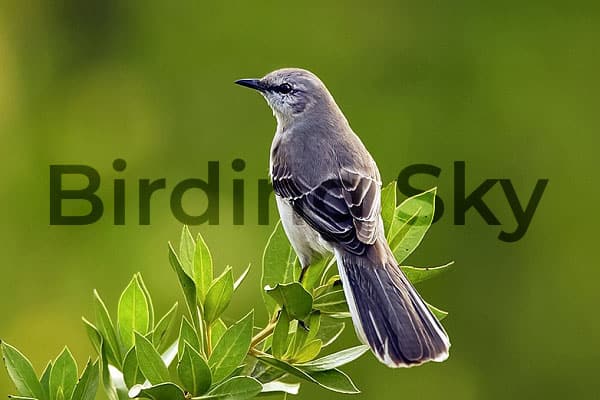
Do you love listening to the songs of different night birds in florida? If you do, you might be surprised to learn that some of the sounds you hear are actually coming from one bird: the Northern Mockingbird. This bird is a versatile and adaptable species that can live in many habitats, from urban areas to forests. It is also a remarkable mimic that can imitate over 200 different sounds, including other birds, car alarms, and even dogs! In this article, you will discover more about this intriguing and charming bird that graces Florida’s landscapes with its presence.
How to Identify the Northern Mockingbird?
The Northern Mockingbird is a medium-sized night birds in florida that measures about 10 inches in length. It has a gray body, a white belly, and two white wing bars. It also has a long tail that it often flicks up and down. The most distinctive feature of this bird is its black eye mask, which gives it a bold and confident look.
How the Northern Mockingbird Defends its Territory
The Northern Mockingbird is a very territorial bird that will not hesitate to defend its nesting area from intruders. It will chase away other birds, animals, and even humans that come too close to its nest. It will also use its mimicry skills to fool potential predators, such as hawks and owls, by imitating their calls and making them think that there are more of them around.
What does the Northern Mockingbird Eat?
The Northern Mockingbird has an omnivorous diet, which means that it eats both plants and animals. It mainly feeds on insects, such as beetles, caterpillars, and ants, but it also enjoys berries, fruits, and small reptiles. It will sometimes visit bird feeders and eat seeds, suet, and peanut butter.
How the Northern Mockingbird Breeds
The Northern Mockingbird breeds from spring to summer, usually between March and August. It builds a cup-shaped nest in a tree or a shrub, using twigs, grass, and leaves. It lays 2-6 eggs per clutch, which are blue-green with brown spots. Both parents share the responsibility of incubating the eggs for about 12 days and feeding the chicks for another 10-12 days until they fledge.
Why the Northern Mockingbird Birds Sing at Night in Florida?
One of the most fascinating behaviors of the Northern Mockingbird is its nocturnal singing. This bird can sing for hours during the night, especially during the full moon. There are several possible reasons why it does this, such as:
- To attract a mate or to keep in touch with its partner
- To warn other mockingbirds of its presence or to deter rivals
- To practice and improve its mimicry skills or to learn new sounds
Whatever the reason, the Northern Mockingbird’s night songs add a magical touch to Florida’s night skies.
2. Yellow-breasted Chat
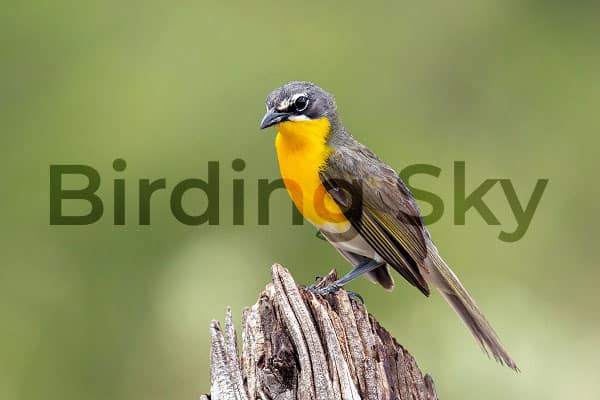
Have you ever heard a strange sound in the night, like a whistle, a chatter, or a grunt? If you have, you might have encountered the Yellow-breasted Chat, a bird that is more often heard than seen. This bird is a secretive and elusive species that hides in dense shrubbery, wetlands, and thickets. It is also a remarkable mimic that can imitate the sounds of other birds and animals. In this article, you will learn more about this enigmatic and fascinating bird that adds to Florida’s nocturnal symphony.
How to Identify the Yellow-breasted Chat?
The Yellow-breasted Chat is a large warbler that measures about 7 inches in length. It has a bright yellow breast, a gray head, and a white eye ring. It also has a long tail that it often flicks up and down. The most distinctive feature of this bird is its large and heavy bill, which helps it crack open seeds and nuts.
How the Yellow-breasted Chat Hides from Predators
The Yellow-breasted Chat is a very secretive bird that prefers to stay concealed in dense vegetation. It rarely flies in the open, and when it does, it often makes a zigzag flight pattern to avoid predators. It also uses its mimicry skills to fool potential predators, such as hawks and owls, by imitating their calls and making them think that there are more of them around.
What the Yellow-breasted Chat Eats
The Yellow-breasted Chat has an omnivorous diet, which means that it eats both plants and animals. It mainly feeds on insects, spiders, and berries, making it important for controlling pest populations. It will sometimes visit bird feeders and eat seeds, nuts, and suet.
How the Yellow-breasted Chat Breeds
The Yellow-breasted Chat breeds from spring to summer, usually between April and July. It builds a cup-shaped nest in a shrub or a low tree, using twigs, grass, and leaves. It lays 3-5 eggs per clutch, which are white with brown spots. The female incubates the eggs for about 11 days and feeds the chicks for another 8-10 days until they fledge.
Why the Yellow-breasted Chat Sings at Night?
One of the most fascinating behaviors of the Yellow-breasted Chat is its nocturnal singing. This bird can sing for hours during the night, especially during the breeding season. There are several possible reasons why it does this, such as:
- To attract a mate or to keep in touch with its partner
- To warn other chats of its presence or to deter rivals
- To practice and improve its mimicry skills or to learn new sounds
Whatever the reason, the Yellow-breasted Chat’s night songs add a mysterious touch to Florida’s night skies.
Must Read: Blackbirds in Colorado
3. Common Night hawk birds in Florida
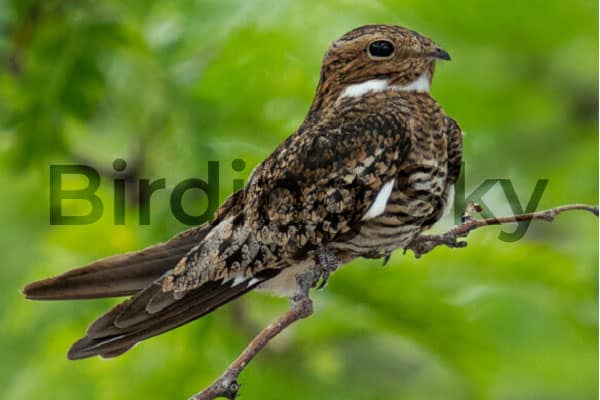
As the sun sets, a mysterious bird takes to the sky. It is the Common Nighthawk, a creature of the night that hunts insects with grace and skill. You can hear its loud “peent” call as it flies over the horizon. What else do you know about this amazing bird? Read on to find out more!
Where does it live?
The Common Night hawk birds in florida can live in many places, from open woodlands to grasslands to cities. It likes to perch on tree branches, fence posts, or rooftops during the day. It blends in well with its surroundings, thanks to its brown and gray feathers.
What does it eat?
The Common Nighthawk is a hungry hunter. It feeds on flying insects, such as moths, beetles, and mosquitoes. It has a wide mouth that helps it catch its prey in mid-air. It can eat hundreds of insects in one night!
How does it breed?
The Common Nighthawk does not make a nest. Instead, it lays its eggs on the ground or on gravel roofs. It usually lays 1-3 eggs at a time. The eggs are speckled with brown and gray, so they are hard to see. The parents take turns incubating the eggs and protecting the chicks.
Why is it called a nighthawk?
The Common Nighthawk is not a hawk at all. It belongs to the nightjar family, which includes other nocturnal birds like whip-poor-wills and chuck-will’s-widows. The name “nighthawk” comes from its habit of flying at night and making a loud noise with its wings. Some people call it a “bullbat” because of its large head and short tail.
4. Chuck-will’s-widow
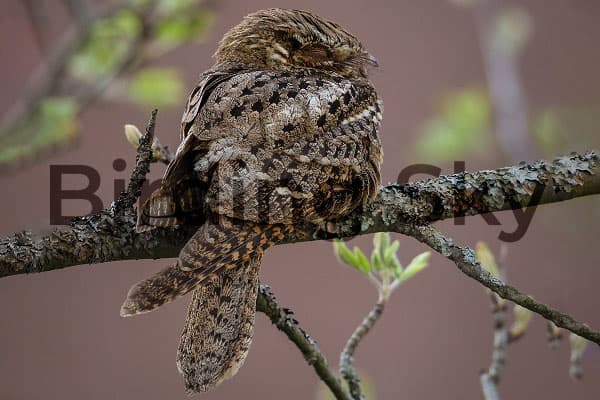
Imagine you are in a forest in Florida at night. You hear a loud and clear voice that repeats the same phrase over and over: “Chuck-will’s-widow”. Who is making this sound? It is a bird that lives in the dark and has a name that matches its call. It is the Chuck-will’s-widow, a mysterious and fascinating bird that you may never see but can always hear. Let’s learn more about this nocturnal singer of the woods!
What does it look like?
The Chuck-will’s-widow is a large bird, about the size of a crow. It has brown, gray, and black feathers that help it blend in with the leaf litter on the forest floor. It has a big head, a long tail, and a wide mouth. It also has large eyes that help it see in the dark.
What does it eat?
The Chuck-will’s-widow is a hunter of the night. It flies low over the ground and catches large insects, such as moths, beetles, and grasshoppers, in its wide mouth. It can eat up to a third of its body weight in insects every night!
Where does it live?
The Chuck-will’s-widow lives in wooded areas, such as pine forests, hammocks, and swamps. It prefers places with dense vegetation and open spaces for flying. It is mostly found in the southeastern United States, but it also migrates to the Caribbean and Central America in the winter.
How does it breed?
The Chuck-will’s-widow does not make a nest. Instead, it lays two eggs on the ground, among the leaves and twigs. The eggs are white with brown spots, so they are hard to see. The parents take turns incubating the eggs and guarding the chicks. The chicks can fly when they are about three weeks old.
Why is it called a Chuck-will’s-widow?
The Chuck-will’s-widow is named after its call, which sounds like it is saying “Chuck-will’s-widow” over and over. The call is loud and can be heard from far away. The bird usually calls at dusk and dawn, but sometimes also during the night. The call is used to attract mates and defend territories. Some people think the call is soothing, while others find it annoying. What do you think?
You May Want to Read: RED BIRDS In Michigan
5. Eastern Whip-poor-will
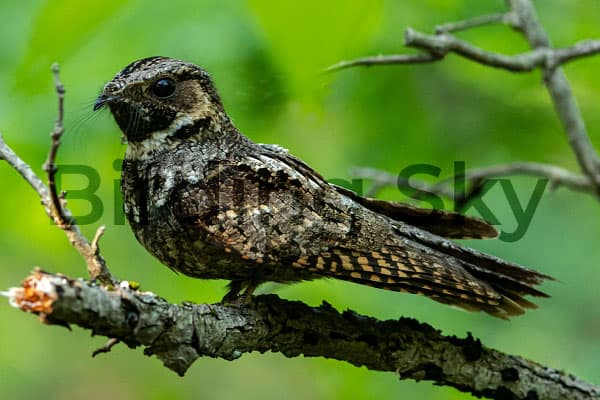
When the sun goes down, a special bird comes out. It is the Eastern Whip-poor-will, a bird that loves the night and has a beautiful voice. You may have heard its call before, a loud and clear “whip-poor-will” that fills the air. But have you ever seen this bird? It is not easy to spot, because it is a master of camouflage. Let’s find out more about this amazing bird and how it lives in the dark!
How does it look?
The Eastern Whip-poor-will is a medium-sized bird, about the size of a robin. It has brown, gray, and black feathers that help it blend in with the leaves and the ground. It has a long tail, a short bill, and a wide mouth. It also has big eyes that help it see in the dark.
What does it eat?
The Eastern Whip-poor-will is a hungry hunter. It feeds on insects that fly at night, such as moths, beetles, and crickets. It catches them in mid-air using its wide mouth. It can eat up to a quarter of its body weight in insects every night!
Where does it live?
The Eastern Whip-poor-will lives in open woodlands, meadows, and fields with plenty of ground cover. It likes places where it can hide during the day and fly easily at night. It is mostly found in the eastern United States, but it also migrates to Mexico and Central America in the winter.
How does it breed?
The Eastern Whip-poor-will does not make a nest. Instead, it lays two eggs on the ground, among the leaves or on bare soil. The eggs are white with brown spots, so they are hard to see. The parents take turns incubating the eggs and caring for the chicks. The chicks can fly when they are about two weeks old.
Why is it called a whip-poor-will?
The Eastern Whip-poor-will is named after its call, which sounds like it is saying “whip-poor-will” over and over. The call is loud and can be heard from far away. The bird usually calls at dusk and dawn, but sometimes also during the night. The call is used to attract mates and defend territories. Some people think the call is soothing, while others find it haunting. What do you think?
Also Visit: BLUE BIRDS In Michigan
6. Black-crowned Night-Heron
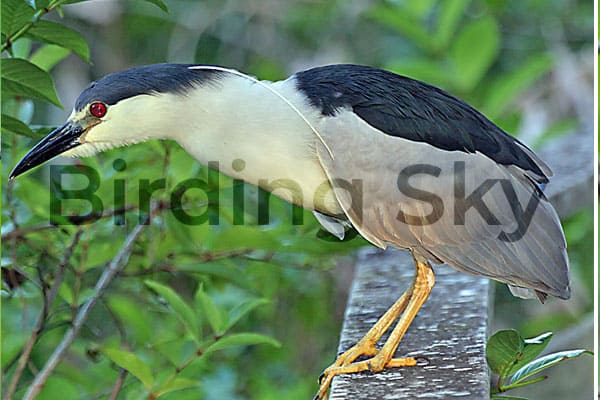
Have you ever seen a bird with red eyes and a black crown? It might be the Black-crowned Night-Heron, a beautiful and unique wading bird that lives near Florida’s freshwater habitats. This bird is a night owl, hunting for fish, frogs, and insects in the dark. Let’s get to know this dazzling bird and how it survives in the night!
Where does it live?
The Black-crowned Night-Heron likes to live near ponds, marshes, and swamps. It prefers places with plenty of water and vegetation. It can be found in most of the United States, but it also migrates to Central and South America in the winter.
What does it eat?
The Black-crowned Night-Heron is a hungry hunter. It eats a variety of aquatic prey, such as fish, amphibians, and crustaceans. It catches them by stabbing them with its sharp bill. It can eat up to 10% of its body weight in food every night!
How does it look?
The Black-crowned Night-Heron is a medium-sized bird, about the size of a duck. It has a black crown, a gray back, and a white belly. It also has long white plumes on its head and a yellow bill. But the most striking feature of this bird is its red eyes, which help it see in the dark.
How does it breed?
The Black-crowned Night-Heron breeds in colonies, often in trees near water. It makes a nest of sticks and leaves, where it lays 3-5 eggs at a time. The eggs are pale blue-green, so they are hard to see. Both parents take turns incubating the eggs and feeding the chicks. The chicks can fly when they are about six weeks old.
Why is it called a night-heron?
The Black-crowned night heron is called a night heron because it is more active at night than during the day. It hunts at dawn and dusk, but sometimes also during the night. It makes a loud and harsh “quok” sound, which can be heard from far away. The sound is used to communicate with other night herons and to scare away predators. Some people think the sound is eerie, while others find it fascinating.
7. Yellow-crowned Night-Heron
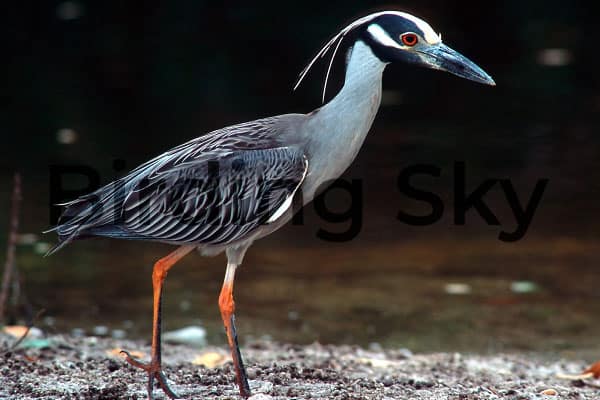
Along the coastal realms of Florida, the Yellow-crowned Night-Heron stands out with its yellow crown and long, white plumes. These skilled hunters use their sharp bills to capture crustaceans, fish, and amphibians in the shallows. Join us in exploring the vibrant world of the Yellow-crowned Night Heron as it navigates the coastal waters of the Sunshine State.
Habit:
Yellow-crowned Night-Herons prefer coastal habitats, including tidal marshes, estuaries, and mangrove swamps.
Behavior:
These birds are skilled hunters, using their sharp bills to catch crustaceans, fish, and amphibians in shallow waters.
Diet:
Their diet mainly consists of crabs, crayfish, and small fish. They are often seen foraging along the shoreline.
Breeding:
Yellow-crowned night herons build stick nests in trees or shrubs near water. They lay 2-4 eggs per clutch.
Fun Fact:
Their striking appearance with a yellow crown and long, white plumes makes them a unique sight in coastal areas.
If you’re a bird lover then must explore the 9 Types Of Doves In California (ID Guide with Photos)
8. Great Horned Owl

Have you ever heard a deep “hoo-hoo-hoo” call in the night? It might be the Great Horned Owl, a symbol of night-time wisdom and strength. This owl is a fierce predator and an excellent hunter, with a varied diet and a powerful grip. It can live in diverse habitats, from forests to deserts to cities. Let’s explore more about this amazing owl and how it rules the night!
How does it look?
The Great Horned Owl is a large bird, about the size of a goose. It has brown and gray feathers that form patterns on its body. It has a broad head, a hooked bill, and yellow eyes. But the most distinctive feature of this owl is its horns, which are actually tufts of feathers on its head. The horns help the owl blend in with its surroundings and communicate with other owls.
What does it eat?
The Great Horned Owl is a hungry hunter. It eats mammals, birds, and even large insects, such as rabbits, skunks, raccoons, ducks, and grasshoppers. It catches its prey by flying silently and using its sharp vision and hearing to locate them. It can kill its prey with one squeeze of its talons, which are strong enough to crush a human skull!
Where does it live?
The Great Horned Owl likes to live in a wide range of habitats, such as forests, deserts, and urban areas. It needs places with plenty of prey and shelter. It can be found in most of North and South America, making it one of the most widespread and common owls in the world.
How does it breed?
The Great Horned Owl breeds in tree cavities or abandoned nests of other birds, such as hawks or crows. It lays 2-3 eggs at a time, which are white and round. Both parents take turns incubating the eggs and feeding the chicks. The chicks can fly when they are about three months old.
Why is it called a great horned owl?
The Great Horned Owl is called a great horned owl because of its large size and its horns, which are actually feather tufts. It is also known as the hoot owl, because of its deep “hoo-hoo-hoo” call. The call is loud and can be heard from far away. The owl usually calls at night, but sometimes also during the day. The call is used to communicate with other great horned owls and to mark its territory.
9. Barn Owl

Imagine you are in a grassland in Florida at night. You hear a screech that sounds like a banshee’s cry. What is making this sound? It is a Barn Owl, a night-time enigma with a haunting call. This bird is a silent hunter, with a heart-shaped face and a taste for rodents. Let’s learn more about this amazing bird and how it lives in the dark!
How does it look?
The Barn Owl is a medium-sized bird, about the size of a pigeon. It has white and brown feathers that form spots and stripes on its body. It has a heart-shaped facial disc, which helps it hear better in the dark. It also has dark eyes and a hooked bill. But the most distinctive feature of this bird is its call, which sounds like a screech or a scream. The call is loud and can be heard from far away. The bird usually calls at night, but sometimes also during the day. The call is used to communicate with other barn owls and to scare away predators.
What does it eat?
The Barn Owl is a hungry hunter. It eats rodents, such as mice, rats, and voles, making it valuable for pest control. It catches them by flying low over the ground and using its sharp hearing and vision to locate them. It can eat up to 10% of its body weight in food every night!
Where does it live?
The Barn Owl likes to live in open habitats, such as grasslands, farmlands, and barns. It needs places with plenty of prey and shelter. It can be found in most of the world, except for polar and desert regions. It is one of the most widespread and common owls in the world.
How does it breed?
The Barn Owl breeds in cavities, where it lays 4-7 eggs at a time. The eggs are white and round, so they are hard to see. Both parents take turns incubating the eggs and feeding the chicks. The chicks can fly when they are about two months old.
10. Burrowing Owl: Night Birds in Florida
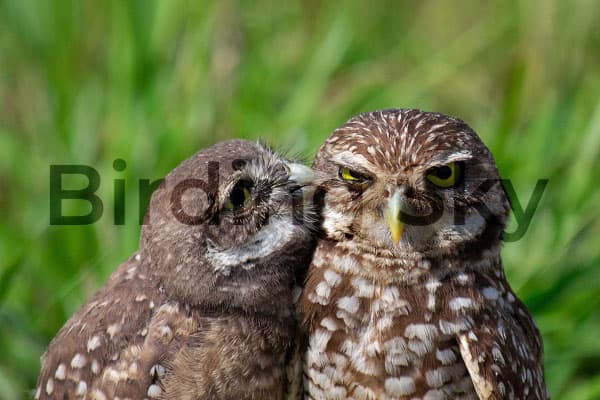
Have you ever seen a bird that lives in a hole in the ground? It might be the Burrowing Owl, a charming and active bird that calls the Sunshine State its home. This bird is not only diurnal, but also nocturnal, thanks to its burrowing habits. You can hear its cooing and clucking sounds as it hunts for insects and small mammals. Let’s find out more about this amazing bird and how it adapts to its environment!
How does it look?
The Burrowing Owl is a small bird, about the size of a robin. It has brown and white feathers that form spots and stripes on its body. It has a round head, a short tail, and long legs. It also has yellow eyes and a white eyebrow. But the most distinctive feature of this bird is its burrow, which is a hole dug in the ground. The bird usually uses burrows made by other animals, such as prairie dogs or tortoises, but sometimes it digs its own.
What does it eat?
The Burrowing Owl is a hungry hunter. It eats insects, such as grasshoppers, beetles, and crickets, as well as small mammals, such as mice, rats, and squirrels. It sometimes also eats small birds, such as sparrows, starlings, and quail. It catches its prey by flying low over the ground or by running and hopping on the ground. It can eat up to 10% of its body weight in food every night!
Where does it live?
The Burrowing Owl likes to live in open grasslands, golf courses, and vacant lots with sandy soil for burrowing. It needs places with plenty of prey and shelter. It can be found in most of the western and southern United States, as well as in parts of Canada, Mexico, and South America. It is one of the most widespread and common owls in the world.
How does it breed?
The Burrowing Owl breeds in burrows, where it lays 4-10 eggs at a time. The eggs are white and oval, so they are hard to see. Both parents take turns incubating the eggs and feeding the chicks. The chicks can fly when they are about six weeks old.
Why is it called a burrowing owl?
The Burrowing Owl is called a burrowing owl because it lives in burrows and is active at night. It hunts at dusk and dawn, but sometimes also during the night. It makes a series of cooing and clucking sounds, which can be heard from far away. The sound is used to communicate with other burrowing owls and to warn of predators. Some people think the sound is cute, while others find it annoying.
11. Short-eared Owl
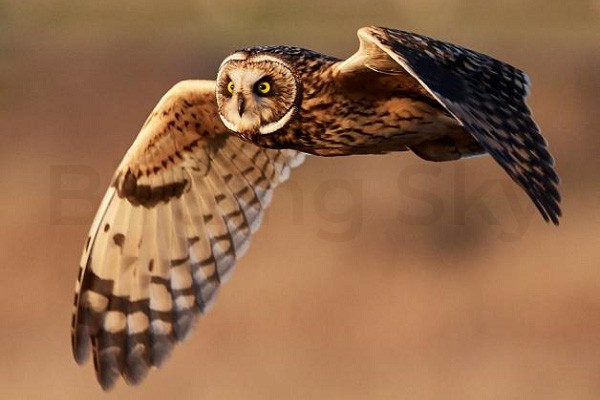
Over Florida’s open fields and marshes, the Short-eared Owl’s barks and hoots echo through the night, a captivating sound that accompanies their hunting expeditions. These owls are known for their distinctive facial disks and striking yellow eyes. Join us in venturing into the nocturnal realm of the Short-eared Owl, a bird of mystery and majesty.
Habit:
Short-eared Owls night birds in florida also inhabit open fields, marshes, and grasslands, where they hunt for rodents.
Behavior:
They have a series of barks and hoots that echo through the night. They are often seen hunting in open fields.
Diet:
Their primary diet consists of voles, mice, and other small mammals.
Breeding:
Short-eared Owls nest on the ground or in low vegetation, laying 4-7 eggs per clutch.
Fun Fact:
Short-eared Owls are known for their distinctive facial disks and striking yellow eyes.
12. Eastern Screech-Owl
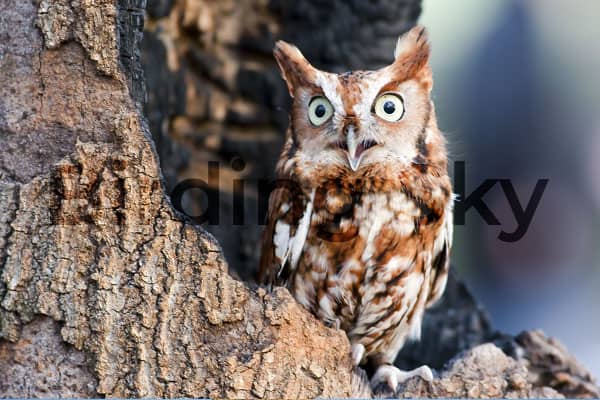
Adaptable to urban environments, the Eastern Screech-Owl graces Florida’s suburban areas, nesting in tree cavities and producing a gentle trill rather than a screech. These skilled hunters with two color morphs, gray and reddish-brown, are a fascinating presence in human-dominated landscapes. Join us in discovering the charms of the Eastern Screech-Owl, a bird that thrives amidst human habitation.
Habit:
Eastern screech owls adapt well to urban environments, often nesting in tree cavities in suburban areas.
Behavior:
Despite their name, they produce a gentle trill rather than a screech. They are skilled hunters and nest in cavities.
Diet:
Their diet consists of insects, small mammals, and occasionally small birds.
Breeding:
Eastern screech owls lay 2-6 eggs per clutch and are known for their adaptability to human-dominated landscapes.
Fun Fact:
These small night birds in Florida come in two color morphs: gray and reddish-brown, providing camouflage in different environments.
13. Barred Owl

Have you ever heard a bird asking “who-cooks-for-you, who-cooks-for-you-all” in the night? It might be the Barred Owl, a wise and adaptable bird that lives in mature forests near water sources. This bird is a night owl, hunting and swimming with skill and ease. Let’s discover more about this amazing bird and how it thrives in the Sunshine State!
Where does it live?
The Barred Owl likes to live in old forests near water sources, such as rivers, lakes, and swamps. It needs large trees with cavities to nest and roost. It is less affected by habitat loss than other owls because it can adapt to different environments. It can be found in most of the eastern United States and Canada, but it also expanded its range to the west coast.
What does it eat?
The Barred Owl is a hungry hunter. It eats small mammals, birds, and amphibians, such as mice, squirrels, rabbits, woodpeckers, and frogs. It catches them by swooping down from a perch or flying low over the ground. It can also swim and dive to catch fish and crayfish in the water.
How does it look?
The Barred Owl is a large bird, about the size of a hawk. It has brown and white feathers that form bars and spots on its body. It has a round head, a yellow bill, and dark eyes. But the most distinctive feature of this bird is its call, which sounds like it is asking “who-cooks-for-you, who-cooks-for-you-all” over and over. The call is loud and can be heard from far away. The bird usually calls at night, but sometimes also during the day. The call is used to communicate with other barred owls and to mark its territory.
How does it breed?
The Barred Owl breeds in tree cavities, where it lays 2-3 eggs at a time. The eggs are white and oval, so they are hard to see. Both parents take turns incubating the eggs and feeding the chicks. The chicks can fly when they are about two months old.
FAQ’s About NIGHT BIRDS In Florida:
Q1: What is the loud bird in Florida at night?
The loud bird in Florida at night is likely the barred owl (Strix varia), known for its distinctive “who-cooks-for-you, who-cooks-for-you-all” call.
Q2: Why do birds sing at night in Florida?
Night Birds in Florida may sing at night for various reasons, such as defending territory, attracting mates, or communicating with other birds. Some species are naturally more vocal during nighttime hours.
Q3: What is a bird that is active at night?
Birds that are active at night in Florida are referred to as nocturnal. Examples include owls, nightjars, and nighthawks, which are adapted to low-light conditions and often hunt or sing during the nighttime.
Q4: What bird sounds like laughing in Florida?
The bird that sounds like laughing in Florida is likely the northern mockingbird (Mimus polyglottos). Mockingbirds are skilled mimics and can imitate various sounds, including laughter and other bird calls.
